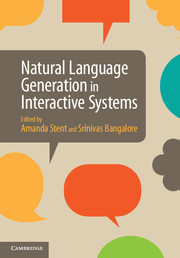Book contents
- Frontmatter
- Contents
- List of contributors
- 1 Introduction
- Part I Joint construction
- Part II Reference
- Part III Handling uncertainty
- 7 Reinforcement learning approaches to natural language generation in interactive systems
- 8 A joint learning approach for situated language generation
- Part IV Engagement
- Part V Evaluation and shared tasks
- Author index
- Subject index
- References
8 - A joint learning approach for situated language generation
from Part III - Handling uncertainty
Published online by Cambridge University Press: 05 July 2014
- Frontmatter
- Contents
- List of contributors
- 1 Introduction
- Part I Joint construction
- Part II Reference
- Part III Handling uncertainty
- 7 Reinforcement learning approaches to natural language generation in interactive systems
- 8 A joint learning approach for situated language generation
- Part IV Engagement
- Part V Evaluation and shared tasks
- Author index
- Subject index
- References
Summary
Introduction
Interactive systems are increasingly situated: they have knowledge about the non-linguistic context of the interaction, including aspects related to location, time, and the user (Byron and Fosler-Lussier, 2006; Kelleher et al., 2006; Stoia et al., 2006; Raux and Nakano, 2010; Garoufi and Koller, 2011; Janarthanam et al., 2012). This extra knowledge makes it possible for the Natural Language Generation (NLG) components of these systems to be more adaptive, changing their output to suit the larger context. Adaptive NLG systems for situated interaction aim to produce the most effective utterance for each user in each physical and discourse context. At each stage of the generation process (what to say or content selection, how to structure content or utterance planning, and how to express content or surface realization), the best choices depend on the physical and linguistic context, which is constantly changing. Consequently, it is key to successful interaction that adaptive NLG systems constantly monitor the physical environment, the dialogue history, and the user's preferences and behaviors. As the representations of each of these will necessarily be incomplete and error-prone, adaptive NLG systems must also be able to model uncertainty in the generation process.
A designer of adaptive NLG systems faces at least two challenges. The first challenge is to identify the set of contextual features that are relevant to decision making in a specific generation situation. The second challenge is to develop a method for selecting a (near-)optimal choice in any given situation from a set of competing ones that may initially appear as viable alternatives. Complicating these challenges is the fact that individual generation decisions are tightly interrelated, so the best decision at one stage may easily depend on others.
Information
- Type
- Chapter
- Information
- Natural Language Generation in Interactive Systems , pp. 180 - 204Publisher: Cambridge University PressPrint publication year: 2014
References
Accessibility standard: Unknown
Why this information is here
This section outlines the accessibility features of this content - including support for screen readers, full keyboard navigation and high-contrast display options. This may not be relevant for you.Accessibility Information
- 1
- Cited by
